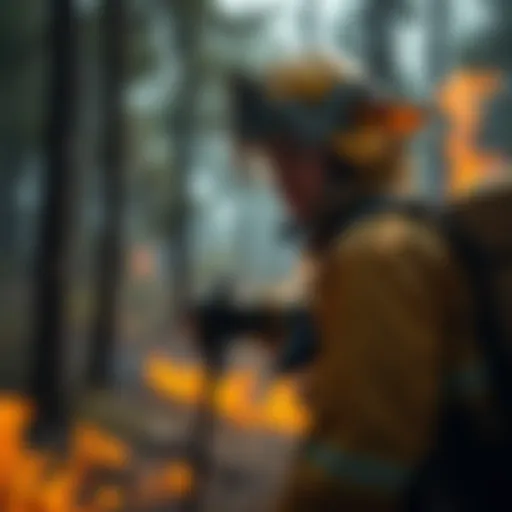Explore Bridger Teton National Forest: Nature's Majesty


Intro
Bridger Teton National Forest is a sprawling expanse of wilderness located in Wyoming. Its landscape offers myriad opportunities for exploration and reflection. From lush valleys to towering peaks, the forest serves as a critical habitat for various plant and animal species. Furthermore, it plays a significant role in discussions on conservation and sustainable management. Understanding the geographical and ecological significance of this area benefits both the public and professionals in the forestry sector.
Understanding Woodland Ecosystems
The ecosystems within Bridger Teton National Forest are diverse. These woodlands are more than just a collection of trees; they are complex systems that support numerous forms of life.
Importance of Biodiversity in Forests
Biodiversity is essential for the resilience of ecosystems. High species diversity contributes to a balance in the ecosystem. In Bridger Teton, various species interact and depend on one another. Some key points include:
- Habitat: Unique habitats support various animal and plant species.
- Ecosystem Services: Diverse forests provide services like air purification and soil erosion control.
- Adaptation: Biodiverse ecosystems can better adapt to environmental changes.
Role of Forests in Climate Regulation
Forests play a pivotal role in climate moderation. They act as carbon sinks, absorbing atmospheric carbon dioxide. In addition, they influence local weather patterns. This relationship underscores why forest conservation is vital.
Forests are indispensable in mitigating climate change and maintaining ecological equilibrium.
Sustainable Forestry Practices
Sustainable forestry seeks to balance ecological health with economic growth. This ensures forests can provide resources without compromising their integrity.
Principles of Sustainable Forestry
Some key principles encompass:
- Maintaining Ecosystem Health: Ensuring forest resilience against pests, diseases, and climate variability.
- Minimizing Environmental Impact: Ensuring management practices limit harm to surrounding ecosystems.
- Community Involvement: Engaging local communities in forest management enhances sustainability.
Case Studies of Successful Implementations
Various initiatives demonstrate successful sustainable forestry practices in similar contexts. One notable example is the adaptive management strategy employed in Oregon’s Tillamook State Forest, which has achieved both timber production and habitat conservation. By analyzing such cases, Bridger Teton can refine its practices further.
Woodland Stewardship Techniques
Managing forests effectively involves various techniques. Stewardship is critical to maintaining ecological integrity.
Forest Management Plans
Creating comprehensive management plans tailored to specific forest conditions is crucial. These plans should outline objectives, resource allocation, and monitoring frameworks. They help ensure sustainability while accommodating recreational needs.
Conservation Strategies
Promoting conservation strategies is essential for preserving the biodiversity within Bridger Teton. This may include:
- Protected Areas: Establishing zones where human intervention is minimal.
- Restoration Projects: Engaging in activities to rehabilitate degraded areas, restoring them to their natural state.
The insights shared here emphasize that Bridger Teton's future relies on informed management practices that harmonize ecological health with human interests. Understanding the intricacies of its ecosystems fosters appreciation and commitment to ensuring their preservation.
Prelims to Bridger Teton National Forest
Understanding the Bridger Teton National Forest is vital for appreciating its ecological and recreational significance. This section aims to delve into the geographical attributes, historical context, and overarching importance of this vast wilderness. It sets the foundation for further exploration of the forest's ecological features and the challenges it faces.
Geographical Overview
Bridger Teton National Forest is located in western Wyoming and covers over 3.4 million acres. The stunning landscape consists of rugged mountains, pristine lakes, and expansive forested areas. Its proximity to the Teton Range and Yellowstone National Park enhances its ecological richness. The varied elevations create microclimates that support diverse ecosystems, from alpine meadows to temperate forests.
The forest's geography plays a central role in its biodiversity. The numerous waterways within the forest provide critical habitats for various species. Additionally, the geological formations contribute to the region's distinct ecosystems, directly influencing the flora and fauna found in the area.
Historical Context
Historically, Bridger Teton National Forest has undergone significant changes. Established in the early 20th century, it was shaped by the conservation movements aimed at protecting vast tracts of land. The forest has a rich cultural history, including Native American utilization of the land long before the establishment of national forestry systems. Early settlers also relied on the forest's resources for sustenance and livelihoods.
As the forest developed, various policies and regulations governed its use and conservation. From timber extraction to recreation, every aspect of land management has left an imprint on the landscape. Understanding this historical context provides critical insight into current management practices and conservation efforts.
Purpose and Importance


The purpose of Bridger Teton National Forest stretches beyond just recreation; it is a critical area for biodiversity conservation and sustainable resource management. The forest supports numerous species, some of which are endangered, and serves as an essential ecological resource for the region. Its preservation is vital for maintaining the health of the surrounding ecosystems.
Moreover, the forest provides numerous benefits to the community and visitors alike. It serves as a recreational haven, offers educational opportunities, and acts as a laboratory for scientific research. Promoting awareness and appreciation of the forest can foster greater stewardship and encourage sustainable practices.
The Bridger Teton National Forest is not just a forest, but a living ecosystem that sustains countless species and supports myriad human activities. Understanding its depth and significance is essential for future conservation efforts.
Ecological Features of the Forest
Understanding the ecological features of Bridger Teton National Forest is essential for comprehending its role in biodiversity conservation and ecosystem stability. This forest is not just a collection of trees; it is a complex web of interactions that supports various forms of life. The forest's ecological significance arises from its vast diversity in flora and fauna, which contributes to both environmental health and recreational value. The interplay of species within this ecosystem provides crucial services that benefit both nature and humans.
Flora Diversity
Flora diversity in Bridger Teton National Forest reflects the ecological richness of the region. The variety of plant species not only maintains the health of the ecosystem but also serves numerous ecological functions.
Dominant Species
Among the dominant species in this forest are the lodgepole pine and Engelmann spruce. Lodgepole pine is especially adapted to the region's climate, making it a key component of the landscape. Its deep root system helps prevent soil erosion, and its needles can survive harsh winters. Engelmann spruce, with its higher elevation preference, supports a range of wildlife, offering shelter and food.
A major characteristic of lodgepole pine is its ability to regenerate quickly after wildfires. This unique feature allows it to thrive in an ecosystem where fire is a natural occurrence. Such resilience is advantageous as it promotes faster recovery of the forest's habitat.
Unique Plants
Bridger Teton is also home to unique plant species such as the alpine forget-me-not, which exhibits remarkable adaptation to its high-altitude habitat. This plant not only adds to the beauty of the landscape but also supports pollinator species, including bees and butterflies, which are critical for the forest's overall health.
The alpine forget-me-not's distinctive blue flowers attract various pollinators, highlighting its role in the ecosystem. Its adaptation to extreme weather conditions makes it a valuable species for studies focused on climate resilience in flora.
Fauna Population
The fauna population in Bridger Teton National Forest is rich and diverse, encompassing numerous species that play vital roles within their ecological niches.
Key Mammals
Key mammals like the elk and moose contribute to the forest's biodiversity. The elk's grazing habits help maintain the balance of plant species, while the moose's unique feeding preferences impact the availability of aquatic flora.
Both species are crucial for maintaining the forest's ecological balance. They provide valuable insights into the health of their habitats, making their tracking and study important for forest management and conservation efforts.
Bird Species
Birds in Bridger Teton, such as the peregrine falcon and the mountain bluebird, contribute significantly to the forest ecosystem. The peregrine falcon, known for its incredible speed, is an apex predator, controlling the population of smaller birds. The mountain bluebird is a vital seed disperser, aiding in plant regeneration.
Each bird species plays a distinct role in the ecosystem—whether it is through predation or seed distribution. This diversity enhances the resilience of the forest to ecological changes.
Endangered Species
The presence of endangered species such as the grizzly bear emphasizes the importance of conservation in Bridger Teton. These bears rely on diverse habitats for foraging and breeding. Protecting their habitats helps ensure the survival of many other species that share the same environment.
Endangered species serve as indicators of ecosystem health, making their protection vital not just for biodiversity, but also for the maintenance of ecological integrity.
Ecosystem Services
Ecosystem services provided by Bridger Teton are pivotal in sustaining both wildlife and human populations. These services include carbon sequestration and water quality maintenance, among others.
Carbon Sequestration
The forest acts as a significant carbon sink, absorbing carbon dioxide from the atmosphere. Trees, through the process of photosynthesis, sequester carbon, which helps mitigate climate change.
The capability of trees to store carbon is pivotal in discussions surrounding global warming and environmental sustainability. By maintaining forest health, we enhance this vital function, making it beneficial for both the environment and society.
Water Quality Maintenance
Bridger Teton also plays a critical role in water quality maintenance. The forest’s plants filter pollutants from water sources, contributing to cleaner waterways. Its wetlands, in particular, act as a natural buffer, reducing sedimentation and filtering contaminants.
By safeguarding the integrity of water bodies, the forest significantly impacts the broader ecosystem, influencing both local and downstream water quality.
Overall, the ecological features of Bridger Teton National Forest embody its significance as a vital component of the region’s environmental health and biodiversity. The interplay of flora and fauna within this wilderness not only enhances its beauty but also contributes to essential ecosystem services that are invaluable to both wildlife and human communities.
Recreational Opportunities
Recreational opportunities in Bridger Teton National Forest offer diverse experiences for nature lovers and outdoor enthusiasts. The variety of activities available not only enhances visitor engagement but also promotes a deeper appreciation for this remarkable ecosystem. This section will cover hiking trails, wildlife viewing, and winter sports, providing insights into their significance and the experiences they offer.


Hiking Trails
Popular Routes
Hiking is a fundamental recreational activity within Bridger Teton National Forest. The popular routes, such as the Teton Crest Trail and Cascade Canyon Trail, serve as gateways to stunning vistas. These trails stand out due to their unique characteristics. For instance, the Teton Crest Trail offers breathtaking views of the Teton Range, attracting hikers seeking both beauty and challenge. While popular for its scenic views, it also presents challenges, including elevation changes that may be troublesome for some hikers.
To enjoy these trails fully, understanding their unique features is crucial. Each route provides distinct flora and fauna experiences, contributing to the richness of the hiking adventure. However, one disadvantage is the potential crowds during peak seasons, which may detract from the experience.
Safety Considerations
Safety considerations are paramount while hiking in the forest. Visitors should be aware of local wildlife, trail conditions, and weather changes. It is vital to prepare adequately by carrying essential gear like first aid kits and navigation tools. The key characteristic of these safety measures is they ensure a more enjoyable and worry-free experience.
Furthermore, planning ahead can mitigate risks. For example, hiking in groups is encouraged, particularly in areas known for wildlife encounters. This practice makes for a safer experience and fosters camaraderie. Balancing adventure with safety is critical; not only does it enhance enjoyment, but it also ensures the preservation of the forest's natural habitats.
Wildlife Viewing
Best Spots
Wildlife viewing presents another rewarding facet of outdoor recreation in Bridger Teton National Forest. Key locations for spotting animals include National Elk Refuge and Oxbow Bend. These areas are popular due to the high likelihood of encounters with species such as elk and bison.
What sets these spots apart? Their accessibility and the abundance of wildlife make them highly favored among visitors. Each location offers unique viewing experiences that vary with the seasons, adding a sense of discovery to every visit. However, the popularity of certain viewings can lead to overexposure, affecting the behavior of wildlife in some cases.
Guidelines
Following specific guidelines while engaging in wildlife viewing can significantly enhance the experience. For instance, maintaining a safe distance from animals ensures both visitor safety and animal welfare. The guidelines emphasize that staying at least 100 yards away from bears and wolves is crucial to avoid any dangerous encounters.
Understanding these considerations can transform a casual observation into a respectful and educational experience. Being mindful of wildlife behavior and habitats also contributes to responsible tourism, which is necessary for the long-term preservation of such natural areas.
Winter Sports
Skiing
Skiing in Bridger Teton National Forest stands out as a thrilling winter adventure. The forest features several trails suitable for different skill levels, making it an ideal destination for both beginners and seasoned skiers. The advantage of skiing here is the vast terrain that caters to a range of experiences. Popular areas, such as Jackson Hole Mountain Resort, provide excellent skiing facilities.
However, winter conditions require careful planning. Visitors must be aware of avalanche risks and make informed decisions about the trails they choose. Informed skiing not only ensures safety but also enhances the quality of the experience by opening access to less crowded paths that are equally stunning.
Snowshoeing
Snowshoeing represents another engaging winter sport popular among visitors. This activity allows individuals to traverse areas not accessible by skis or foot during the winter months. The trails are less crowded, and snowshoeing is suitable for various skill levels. This sport offers a leisurely way to experience the winter landscape, making it appealing for families.
Yet, like skiing, snowshoeing demands preparation and awareness of weather conditions. Winter gear must include layers to ensure warmth against the cold, as well as waterproof equipment. Furthermore, snowshoers should remain on marked trails to protect sensitive areas and promote environmental stewardship.
The recreational opportunities available in Bridger Teton National Forest not only promote enjoyment but also foster a sense of connection with nature, essential for both personal well-being and conservation efforts.
Through physical activity in these natural settings, visitors can appreciate the delicate balance that defines Bridger Teton National Forest.
Forest Management Challenges
Forest management is a critical aspect of maintaining the integrity and health of Bridger Teton National Forest. Many challenges affect the forest's sustainability and the biodiversity it supports. Recognizing these issues can help stakeholders address them effectively. The following sections delve into the specific challenges of climate change, wildfire risks, and invasive species that threaten the forest’s ecological balance.
Climate Change Impact
Climate change exerts significant pressure on Bridger Teton National Forest. It alters weather patterns, affecting both temperature and precipitation. This change can lead to shifts in plant and animal habitats. Some species may thrive, while others may face extinction due to unsuitable conditions.
Warmer summers and altered snowfall patterns can lead to more prolonged dry periods. These conditions increase the vulnerability of the forest to pests and diseases, which might further weaken the ecosystem. Additionally, tree mortality can rise in response to prolonged drought, impacting food sources and habitat for wildlife. Monitoring these changes is vital for planning and adaptation, ensuring the forest remains resilient.
Wildfire Risks
Wildfires pose another significant threat to Bridger Teton National Forest. Although fire is a natural part of forest ecology, the increasing frequency and intensity of wildfires are alarming. Changes in climate and human activities exacerbate this risk.
Fuel loads, created by dead trees and underbrush, can feed fires, making management of these materials essential. Some strategies for reducing fire risks include:
- Prescribed burns: Controlled burns can reduce fuel load.
- Thinning projects: Removing smaller trees can help prevent the spread of wildfires.
- Monitoring and early detection: Efforts to detect fires early can prevent escalation.
Without proper management, these events can have devastating impacts on the forest's ecology. The ripple effects also influence air quality and human health beyond the forest edges.
Invasive Species


Invasive species represent a considerable challenge for the forest's ecosystem. These non-native plants, animals, and pathogens can outcompete native species, disrupting local biodiversity. Species such as cheatgrass and zebra mussels have been noted to encroach upon natural habitats within Bridger Teton.
The management of invasive species includes:
- Monitoring: Continual observation of ecosystems to detect invasive species early.
- Control efforts: Strategies may include manual removal or the use of chemicals, depending on the species involved.
- Public awareness: Educating visitors and the community about the effects of invasive species promotes involvement in management efforts.
These practices are essential for preserving the forest's natural integrity and the diverse wildlife it supports.
"Active management of these challenges is crucial to maintain the health of Bridger Teton National Forest for the future."
Conservation Efforts and Strategies
Conservation efforts in Bridger Teton National Forest are indispensable for safeguarding its unique ecology and natural landscapes. As the world faces increasing environmental challenges, these strategies focus on maintaining the delicate balance of ecosystems and ensuring the survival of various species that inhabit the area. The interplay between community involvement, sustainable practices, and regulatory frameworks form the backbone of comprehensive conservation strategies. Understanding these elements is critical for forestry professionals and academics alike, as these efforts have broad implications for biodiversity, recreation, and climate resilience.
Community Involvement
Active community involvement plays a pivotal role in the success of conservation efforts. Local organizations, volunteers, and stakeholders contribute significantly to environmental stewardship. Their participation ensures that diverse voices and perspectives are included in the decision-making process.
Many initiatives encourage residents to engage with the forest actively. For instance, educational programs help citizens appreciate their natural surroundings. Additionally, community-led clean-up events and habitat restoration projects create a sense of ownership and responsibility towards the forest.
Benefits include:
- Increased awareness about local ecosystem issues.
- Enhanced volunteer participation in restoration efforts.
- Building collaborative relationships between agencies and the public.
Involving community members not only promotes conservation but also strengthens the social fabric around Bridger Teton National Forest.
Sustainable Practices
Sustainable practices are essential in reducing the environmental impact of human activities within the forest. These practices aim to ensure that resource use does not compromise the ecosystem's integrity for future generations. Key areas include tourism management, waste reduction, and habitat preservation.
For instance, eco-friendly tourism practices encourage responsible visitor behavior. Limiting trail expansions and promoting low-impact outdoor activities help preserve the area's natural beauty while allowing public enjoyment. Here are some sustainable practices that can be implemented:
- Use of biodegradable materials for outdoor events.
- Encouragement of public transport to reduce emissions.
- Promotion of native species in landscaping and restoration projects.
Adopting such sustainable methods guarantees that Bridger Teton National Forest remains a thriving environment despite the growing pressures from modern activities.
Regulatory Framework
The regulatory framework that governs conservation efforts is critical in determining the policies and practices that manage the forest's resources. Several key laws and guidelines provide the basis for effective conservation strategies. This framework often involves collaboration between various levels of government and organizations committed to environmental protection.
In Bridger Teton National Forest, regulations are in place that span from habitat protection to recreational usage. These laws help balance ecological health and public enjoyment, although they can sometimes lead to conflicts among stakeholders. Key regulations include:
- National Environmental Policy Act (NEPA) mandates assessment of environmental impacts from proposed projects.
- Endangered Species Act, which protects species at risk of extinction and their habitats.
- Forest Management Plans, outlining goals for sustainable forest use.
By adhering to these regulatory frameworks, conservation efforts can be both effective and transparent. Such regulations not only protect the ecosystems but also empower communities to be proactive in conserving their environment.
The Future of Bridger Teton National Forest
The future of the Bridger Teton National Forest is crucially tied to how we manage and preserve its diverse ecosystems today. As pressures from climate change, human activity, and ecological shifts become more pronounced, strategic planning will be essential. This section explores developmental elements and considerations vital for ensuring this remarkable wilderness thrives for future generations.
Research and Monitoring
Ongoing research and monitoring stand as fundamental practices for the future stewardship of Bridger Teton National Forest. Various studies are essential for understanding the changing dynamics within the ecosystem. Researchers are focusing on:
- Flora and Fauna Changes: Documenting shifts in plant and animal populations helps assess the impacts of climate variation and habitat alterations. For instance, the emergence of new plant species while others may dwindle illustrates ecological adaptability.
- Soil Quality and Composition: Monitoring soil health is vital because it supports vegetation stability and biodiversity.
- Water Resources: Assessing watershed conditions enables better water conservation strategies.
Through coordinated efforts among governmental and academic institutions, precise data collection allows forest managers to make informed decisions. The research findings can guide actionable strategies that respect both conservation goals and recreational needs.
Long-term Vision
A long-term vision for Bridger Teton National Forest involves a commitment to sustainability and ecological balance. This vision incorporates several key aspects:
- Sustainable Tourism: Promoting activities that minimize environmental footprints helps maintain the natural landscape.
- Community Engagement: Involving the local community in conservation efforts fosters a sense of ownership and responsibility regarding forest resources.
- Education and Awareness: Raising public awareness about ecological issues through educational programs can build support for necessary conservation initiatives.
By establishing a comprehensive plan that addresses current challenges while anticipating future challenges, forest management can ensure that the forest remains a haven for biodiversity and recreation.
Role in Biodiversity Conservation
The Bridger Teton National Forest plays a critical role in biodiversity conservation in the region. This role is particularly important for the following reasons:
- Habitat Preserver: The forest serves as a refuge for numerous species, many of which are threatened or endangered. Protecting these natural habitats is vital for their survival.
- Corridor for Wildlife: It connects different ecosystems, allowing for species migration and promoting genetic diversity.
- Research Opportunities: The diverse ecosystem serves as a natural laboratory for studying ecological interactions, which can inform broader conservation strategies elsewhere.
The conservation efforts at Bridger Teton National Forest not only benefit local ecosystems but also contribute to global biodiversity preservation.
In summary, the future of the Bridger Teton National Forest hinges on proactive measures in research, community engagement, and long-term conservation strategies. A balanced approach can secure the health of its ecosystems, ensuring their integrity for generations to come.







